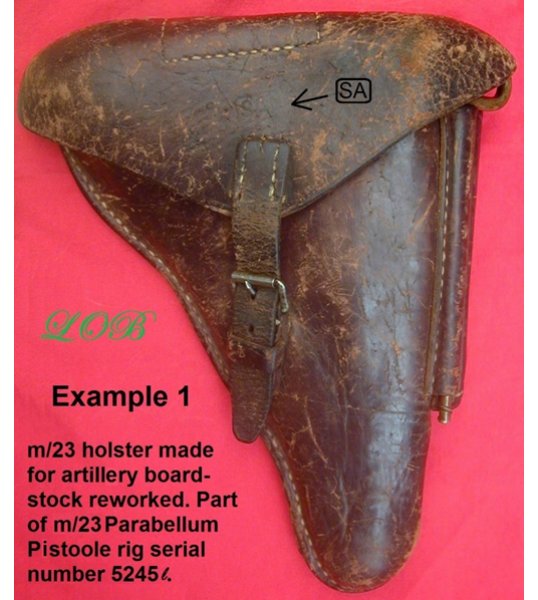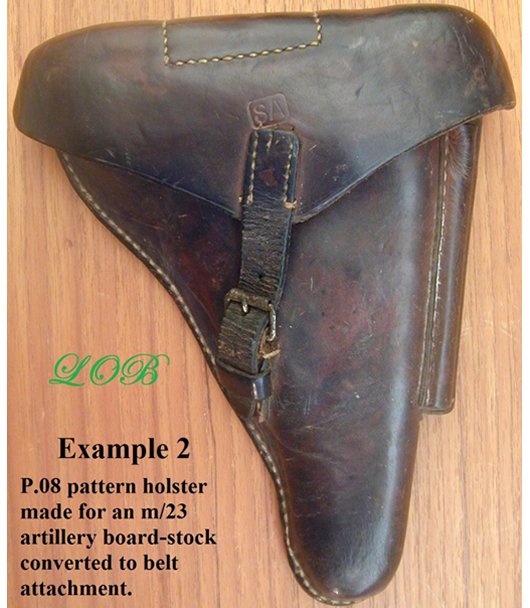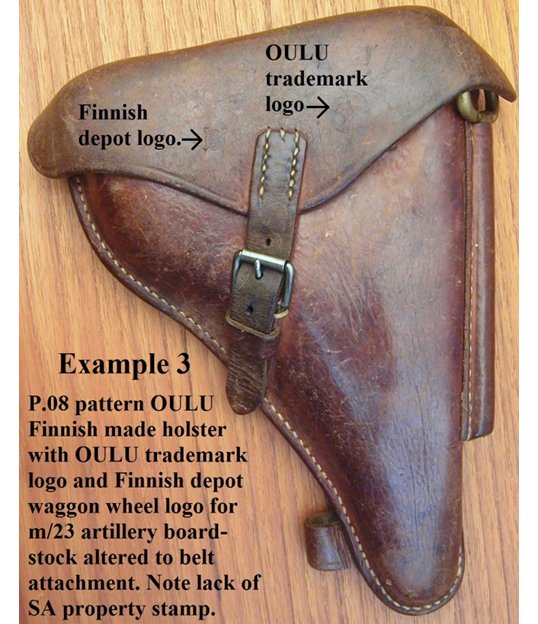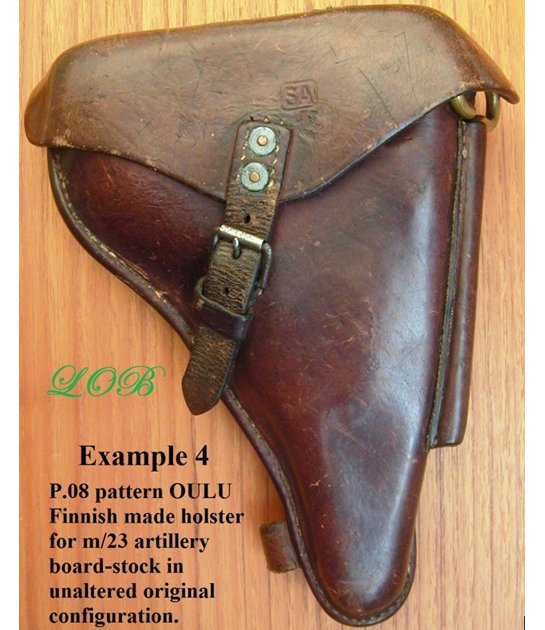buttons
The original m/23 holster cradle strap construction
The original board-stock holster, as stated by Walters, had an unusual belt loop/stock configuration, consisting of two horizontal leather straps attached to the upper holster backing with four rivets. Attached to the two horizontal straps were two vertical belt loop straps, also attached by rivets, making a cradle for the upper wider part of the board-stock. The holster/stock arrangement worked using gravity as while the rig was attached to the soldier’s belt, the stock could be removed simply by lifting it out of the holster belt loop cradle and the lower toe strap. The pistol could then be removed from the holster, still attached to the soldier’s belt, and attached to the board stock iron. The m/23 was, according to published information, per contract, issued with an unused spare DWM WWI artillery holster/board stock, but not many have been found and were, apparently discarded, in some examples involving the subsequent removal the holster toe securing strap. The m/23 holster with the strap affixed to the holster toe can be seen, front view only, pictured in the Finnish handbooks, featured herein.
Seeing the difficulty of attaching the board/stock to the m/23 in the field, possibly under severe winter conditions, being a two-step process, requiring setting aside the pistol or the board stock, whichever was withdrawn first, while the other was withdrawn, then attaching the board stock attaching iron to the m/23 attaching lug would be a bit cumbersome. It is not hard, therefore, to imagine in those circumstances that many holsters were, possibly depot converted for belt carriage, hence the subject rarity of any surviving Finnish army SA stamped board stocks and especially board-stock-holster rigs. Also it is not clear why the Finnish Army required a board-stock to convert the m/23 pistol into a carbine when the m/23 Luger is a close combat weapon.

Example 1 shown above is an m/23 board-stock holster and except for the SA property stamp on the cover flap, has no makers mark and no Finnish depot acceptance logo stamp. It has been modified for belt use in the quickest, most expedient manner by removing the four cross-pattern installed leather straps for the board-stock, leaving the four rivet holes. Simply making two, slightly uneven vertical cuts, completely through the holster back side made an instant, integral belt loop, of which the cuts can also be seen from inside the holster body. Obviously a modification hurriedly made in the field. The example 1 holster resembles a German P.08 commercial pattern as described above.

Example 2 shown above is a German P.08 pattern commercial holster with only an SA property stamp and without a Finnish depot two cannons in saltire acceptance stamp was also originally issued to be used with the Finnish m/23 board-stock as there is an extra layer of leather sewn to the lower body spine about the width of the leather strap, used to secure the board-stock to the holster toe and on the other side of the toe can be seen the other end or edge of the strap, sandwiched or wafered between the holster backing and the front of the holster, which has been deliberately cut flush to the holster body.
The modification of the upper horizontal and vertical strap configuration was accomplished to the example 2 m/23 holster in the following manner: The belt loop straps, as currently located, are rather far apart on the holster, because in order to convert the holster from a board-stock configuration without adding extra holes to the holster backing, the two horizontal leather straps, which were attached to the upper holster back, along with the two vertical belt loops, were removed and then separated from each other. The horizontal straps were discarded while the shorter vertical belt loops were retained and not wanting to make additional holes, were reattached to the holster back directly, using the existing upper and lower horizontal leather strap holes. Apparently some difficulty was encountered reattaching the upper left leather belt loop to the subject holster body as the belt loop rivet is attached through the holster on the backside in a normal manner, yet inside the holster is secured with what appears to be field or depot repair, a pan head, slotted screw.

Example 3, shown above, at first glance appears to be an unmodified original OULU made m/23 board-stock holster. However, it has been modified for direct belt carriage in the simplest manner. Small holes were made through the center length section of the upper and lower horizontal cradle straps and continued directly through the holster backing. A piece of twine or string was fed through the strap holes and through the holes in the holster backing. This was done to resist the downward pull of the weight of the holster and pistol while carried on the belt, now without the support of the absent board-stock. The modification required no other changes, leaving the original holster board-stock configuration undisturbed, even leaving the now unnecessary integral holster toe strap. An artillery board-stock cannot be inserted without cutting the string, of which the vertical section of the string can be seen on the holster rear and inside the holster body rear wall along with some unusual materiel covering the belt-loop rivets. This OULU made holster has the OULU trademark logo and a Finnish depot acceptance stamp logo on the cover flap and most notably lacks the 1942 instituted new SA property stamp, suggesting the holster was accepted into Finnish army inventory in the 1920-1930 time frame. Also under the cover flap is a deeply stamped four-digit number 2617.

Example 4, pictured above, is an OULU Finnish made m/23 board-stock holster in unmodified condition except for two arsenal added reinforcing rivets in the cover flap leather strap. The cover flap is stamped with the OULU trademark logo, the Finnish depot stamp logo and the 1942 instituted SA property stamp suggesting the holster was first accepted into Finnish inventory in the 1920-1930 time frame, as evidenced by the Finnish depot logo and subsequently, later stamped with the SA property stamp. This holster has the added distinction of two stamped four-digit numbers on the inside of the cover flap, being 2387 which is identical in font style and size as the number in example 3 along with an additional four-digit number 4108 in a different style font and smaller size.
If, as stated above, examples 1 and 2 holsters are of German origin, there are two possibilities that come to mind;
- Even though not mentioned in the 1922 contract between DWM and the Finnish army, sometime in the approximately seven year 1923-1930 batch delivery schedule of about 8000 m/23 Lugers, that some holsters were made by DWM subcontract leather makers for the Finnish.
- The Finnish army independently contracted with German leather makers for an undisclosed amount of board-stock configured holsters.


Pictured is a recent Rock Island Auction, a.k.a. RIA auction item, Lot # 406 Finnish m/23 Luger and board- stock with a Finnish m/23 holster, being example 4 described above. The m/23 Luger serial number 4108l is a standard refurbished/reworked import example with a better than average refinish, being SA and vertical crown N stamped on the receiver left side with possibly, the original DWM installed 30 Cal barrel, although the barrel length is 98mm indicating the barrel, per Pistole Parabellum by Görtz/Sturgess which states the barrels in the k through q suffix have 96mm barrels, whereas the 98mm barrel is found on later m/23 batch deliveries in the r through t suffix serial number range. In the case of 4108l the barrel could be a later delivery spare or came from a later delivery gun. The full serial number is on the frame with the last two-digits on the rear link only. The balance of the small parts, including the barrel, have no serial numbers. The barrel underside is import stamped with an “older” CAI import marking per a major Luger dealer, on the bottom of an un-proofed and un-numbered barrel, in two lines, through the reblue: “CAI ST.VT.” – “M-23 GER. 7.65 PARA.”. The breechblock and the barrel underside, if of DWM manufacture, should have the commercial crown N proof but was probably removed. The wooden grips are probably replacements, done long ago when the use or the brass disc was abandoned.1 All the small parts that were originally strawed are blued, except for the unnumbered trigger and the ejector. Interestingly, the magazine wooden bottom is SA property stamped. Some of these arsenal reworked m/23 pistols have been offered recently with aftermarket added blank brass discs. The original unit ID stamped brass discs were originally, invariably installed in the right wooden grip with two pan-head brass screws, some attached with copper rivets, almost all were simply removed, leaving an exposed circular recess in the right wooden grip. Pictured below are two such m/23 reworks with aftermarket added blank brass discs.
 |
 |
The holster shown below is a rare, unmodified SA Finnish army property stamped example, as originally made in Finland by OULU, configured to be used with a DWM contract provided, unused Imperial German army LP.08 artillery board-stock as described above. The RIA board-stock, however, is an aftermarket replica based on the lack of the five unused pilot screw holes for the artillery holster leather attachment straps. Without inquiry it would have been impossible to determine the originality of the board-stock and holster because, as pictured by RIA, only showed the front side of the holster/board stock. The holster, additionally, as presented by RIA was not shown in its normal location on the board stock. A request to RIA for pictures of the other side of the board-stock, with and without the holster, revealed that the holster was original, but the RIA board stock had none of the characteristics described above. Although very accurate their description of the m/23 Luger, the RIA text description of the board-stock makes no claim of originality or authenticity, simply stating: …and the stock has light pressure dents and scratches.

After a personal examination of the RIA board stock it is very similar to an ODIN aftermarket reproduction artillery board-stock and has no “light pressure dings and scratches” as described by RIA.

